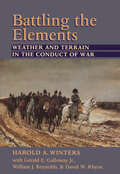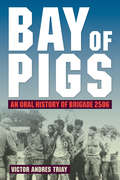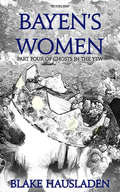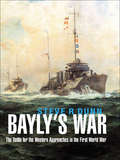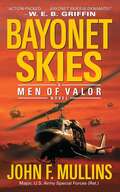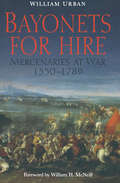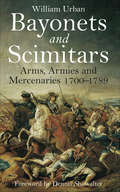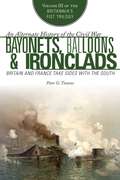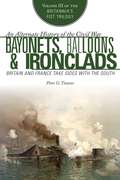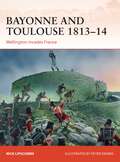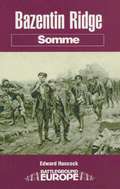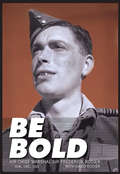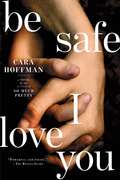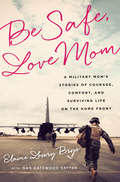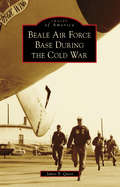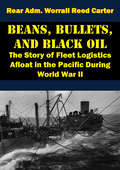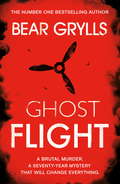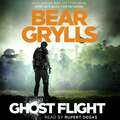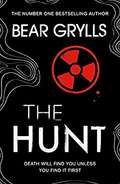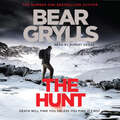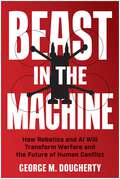- Table View
- List View
Battling the Elements: Weather and Terrain in the Conduct of War
by Harold A. WintersThroughout history, from Kublai Khan's attempted invasions of Japan to Rommel's desert warfare, military operations have succeeded or failed on the ability of commanders to incorporate environmental conditions into their tactics. In Battling the Elements, geographer Harold A. Winters and former U.S. Army officers Gerald E. Galloway Jr., William J. Reynolds, and David W. Rhyne, examine the connections between major battles in world history and their geographic components, revealing what role factors such as weather, climate, terrain, soil, and vegetation have played in combat. Each chapter offers a detailed and engaging explanation of a specific environmental factor and then looks at several battles that highlight its effects on military operations. As this cogent analysis of geography and war makes clear, those who know more about the shape, nature, and variability of battleground conditions will always have a better understanding of the nature of combat and at least one significant advantage over a less knowledgeable enemy.
Bay of Pigs: An Oral History of Brigade 2506
by Victor Andres TriayFlorida Historical Society Samuel Proctor Award <p><p> From the interviews: <p><p> "My [pregnant] wife once asked me, ‘How is it possible you are not thinking of your child?’ I told her, ‘It is precisely because of that child and the two others I have here that I am going. I plan to return to my fatherland, and I don’t want a Communist homeland.’"-- Jorge Marquet <p><p> "One of the sad things that has happened over this period in the history of Cuba is that historians have not given credit to the idealism of those who turned against the revolution. We were really full of good will and wanted to make Cuba better."--Eduardo Zayas-Bazán <p><p> "[A] feeling of duty to defend our faith was what motivated my husband . . . . What made me give my blessing to his activities were my own feelings of duty."-- Myrna Pardo Millán (widowed by the invasion) <p><p> This is the story of the Bay of Pigs invasion, told for the first time in the words of the idealistic participants who came together in April 1961 to overthrow Fidel Castro’s dictatorship. Most of the approximately 1,500 men of Brigade 2506 were captured by Castro’s forces in Cuban swamps and jailed until December 1962. About 114 died. <p><p> Combining oral history and traditional narrative form, Victor Triay tells us who individual members of the brigade were and what they fought for. As one veteran, only eighteen at the time of the invasion, recalls, “It was my turn to do something for Cuba. Probably the purest thing I have ever done in my life was to make the decision to go.” Triay describes the volunteers’ recruitment, training, combat experience, and the wretched months of their imprisonment. He also presents the women they left behind, including three who were widowed by the invasion. <p><p> Among the nearly 2 million people in the U.S. Cuban community today, the freedom fighters who made up Brigade 2506 have always been accorded the highest level of respect. Bay of Pigs tells the personal stories of the invasion in an account that restores the human dimension to a pivotal moment in the history of the Cold War.
Bayen's Women (Ghosts in the Yew #4)
by Blake Hausladen“The soldier, the drunk, the spoiled prince, and the woman he sent to be trained to service him, each of these main characters narrates the story, adding their own point of view and coloring the events of the tale in a way that is engaging and unique.” – Natasha, GoodreadsThis novella is part four of Ghosts in the Yew, also available as a collection.The capital takes notice of Enhedu and the depths of one man's magic are tested.“If you cross this bridge with us, what awaits you is pain. Some do not survive it, so the decision to bring you was not made lightly. We cannot help you, and once started, there is no turning back.”Love is worth fighting for in this epic fantasy surrounded by the mystery of old gods, blood magic, and statecraft. Ignited by redemption and conquest, this journey will test their struggles to survive and will put them at odds with their families, their nation, and the very powers that shaped the world. But, this story is bigger than these things.It’s bigger than all of us.You can read the trilogy in full volumes, or broken up into five novellas each.The Vestal Series1. Ghosts in the Yew Novella 1 - Beyond the Edge Novella 2 - Opposing Oaths Novella 3 - Reckless Borders Novella 4 - Bayen's Women Novella 5 - Falling Tides2. Native Silver Novella 1 - Sutler's Road Novella 2 - Forgotten Stairs Novella 3 - Thrall's Wine Novella 4 - Corsair Princess Novella 5 - Tanayon Born 3. The Vastness Novella 1 - Silent Rebellion Novella 2 - The River War Novella 3 - The Blinded Novella 4 - Crimson Valley Novella 5 - Singer's Reward"While Ghosts in the Yew is action filled and magical, Mr Hausladen has obviously done his research and brings his high-finance background to bear in developing a detailed and complex background that includes socio-economic underpinnings and drivers in a world that seems all too realistic." – RickM, Goodreads
Bayly's War: The Battle for the Western Approaches in the First World War
by Steve R DunnBaylys War is the story of the Royal Navys Coast of Ireland Command (later named Western Approaches Command) during World War One.Britain was particularly vulnerable to the disruption of trade in the Western Approaches through which food and munitions (and later soldiers) from North America and the Caribbean and ores and raw materials from the Southern Americas, all passed on their way to Liverpool or the Channel ports and London. After the sinking of the Lusitania in May 1915 and the introduction of unrestricted submarine warfare by the Germans, Britain found herself engaged in a fight for survival as U-boats targeted all incoming trade in an attempt to drive her into submission. Britains naval forces, based in Queenstown on the southern Irish coast, fought a long and arduous battle to keep the seaways open, and it was only one they began to master after American naval forces joined in 1917.Vice-Admiral Sir Lewis Bayly was the man appointed to the Coast of Ireland Command. A fierce disciplinarian with a mania for efficiency, and thought by some of his colleagues to be more than a little mad, Bayly took the fight to the enemy. Utilising any vessel he could muster trawlers, tugs, yachts as well as the few naval craft at his disposal, he set out to hunt down the enemy submarines. The command also swept for mines, escorted merchantmen and fought endlessly against the harsh Atlantic weather. Relief came When America sent destroyers to Queenstown to serve under him, and Bayly, to the surprise of many, integrated the command into a homogenous fighting force.Along the way, the Command had to deal with the ambivalent attitude of the Irish population, the 1916 Easter Rising, the attempt to land arms on Irelands west coast and the resurgence of Irish nationalism in 1917.Baylys War is a vivid account of this vigorous defence of Britains trade and brings to life the U-boat battles, Q-ship actions, merchant ship sinkings and rescues as well as the tireless Bayly, the commander at the centre.
Bayonet Skies: Men of Valor (Men of Valor #3)
by Mullins John F.Special Forces veteran John F. Mullins delivers heart-pounding action under fire in his third Men of Valor novel. 1975: With the Vietnam War drawing to a close, Captain James Carmichael begins a new life far from the front lines, in Bad Tölz, Germany. Married to a beautiful Russian émigré and awaiting his first child, Carmichael should be content training the 10th Special Forces for a European conflict that will likely never come. But the peacetime army is unmanageable, plagued by drugs and misbehavior, and Carmichael hungers for something more. That appetite gets fed when he is asked to rescue a P.O.W. being held by the North Vietnamese. It's a deadly proposition with dangerous odds, to which his wife bitterly objects. But Carmichael must answer the call of loyalty and risk everything he has -- on one last mission to bring his men back alive.
Bayonet to Barrage: Weaponry on the Victorian Battlefield
by Stephen ManningHow advances in weapons technology transformed the British soldier’s experience of war during the nineteenth century.How did technical advances in weaponry alter the battlefield during the reign of Queen Victoria? In 1845, in the first Anglo-Sikh War, the outcome was decided by the bayonet; just over fifty years later, in the second Boer War, the combatants were many miles apart. How did this transformation come about, and what impact did it have on the experience of the soldiers of the period? Stephen Manning, in this meticulously researched and vividly written study, describes the developments in firepower and, using the first-hand accounts of the soldiers, shows how their perception of battle changed.Innovations like the percussion and breech-loading rifle influenced the fighting in the Crimean War of the 1850s and the colonial campaigns of the 1870s and 1880s, in particular in the Anglo-Zulu War and the wars in Egypt and Sudan. The machine gun was used to deadly effect at the Battle of Omdurman in 1898, and equally dramatic advances in artillery took warfare into a new era of tactics and organization.Stephen Manning’s work provides the reader with an accurate and fascinating insight into a key aspect of nineteenth-century military history.
Bayonets For Hire: The U.S. Artillery from the Civil War to the Spanish-American War, 1861–1898
by William UrbanFrom the Greek professional armies of Alexander, through the Hundred Years War, indeed, to today, mercenaries have been ever-present, their role constantly evolving. In this compelling new history William Urban takes up their captivating and turbulent story from 1550 to 1789: from the Wars of Religion to the eve of the French Revolution. William Urbans many works include the highly acclaimed The Teutonic Knights and Medieval Mercenaries. William McNeill is the author of The Rise of the West and is among the worlds most respected historians.
Bayonets and Scimitars: Arms, Armies and Mercenaries 1700–1789
by William UrbanA look at the tumult and transformations in warfare during the eighteenth century—and the world-changing events that resulted. The eighteenth century in Europe was a period of significant economic, political, and technological upheaval—which led to the American and French revolutions, and ultimately paved the way for Europe&’s domination of much of the world during the nineteenth century. The wars and political maneuvering of Frederick the Great and Catherine the Great transformed Prussia and Russia into major players in European politics. France, then the richest nation in the West, survived losing successive wars, then bankrupted itself assisting the Americans in an unnecessary war of revenge. Britain became the model of economic and financial efficiency and made itself supreme in North America, the Caribbean, and in India, only to face such financial troubles that its leaders antagonized its colonial subjects in America. This engaging new book by an esteemed military historian traces the evolution of war-making throughout this turbulent period—the politics, the weaponry, the organization of armies, and the transformation of mercenaries into professionals. This illuminating and highly readable account concentrates not just on high politics and military strategy, but also on the everyday experiences of those involved, giving us a fascinating glimpse into the human drama of eighteenth-century warfare.
Bayonets, Balloons & Ironclads: Britain and France Take Sides with the South (Britannia's First Trilogy #3)
by Peter G. TsourasThis fascinating third volume in the Britannia's Fist series will have you pondering how easily history could have been swayed differently.What if other countries had become involved in America’s Civil War? Historian Peter G. Tsouras presents the third installment in his Britannia’s Fist alternate history series. The winter of 1863 lowered a white curtain on the desperate struggle for North America. The United States and Great Britain fought each other to a bitter draw. On both sides of the Atlantic, the forges of battle glowed as they poured out new technologies of war. British and French aid transformed the ragged Confederate armies and filled them with new confidence. Both sides strained to be ready for the coming campaign season. Both sides seek to anticipate each other.The British strike suddenly at Hooker’s strung-out army in winter quarters in upstate New York in a brutal, swirling, late battle across frozen fields and streams. Besieged Portland shudders relentless assault. The French attack Fort Hudson on the Mississippi. At Lincoln’s direction, two great raids are launched at the United Kingdom itself as Russia enters the war on the side of the Union to raid the Irish Sea. These are only preliminaries to the great gathering of modernized armies and ironclad fleets, and with them are deadly submersibles and balloons.Battles rage from Maine to northern Virginia and the Chesapeake Bay, down to steamy Louisiana. And far away across the sea, Dublin stands siege as Russia simultaneously eyes Constantinople. For Americans (blue and gray), Britons, Irish, Frenchmen, and Russians, the summer of 1864 is the crescendo battle of destinies and dreams.Skyhorse Publishing, as well as our Arcade, Yucca, and Good Books imprints, are proud to publish a broad range of books for readers interested in fiction?novels, novellas, political and medical thrillers, comedy, satire, historical fiction, romance, erotic and love stories, mystery, classic literature, folklore and mythology, literary classics including Shakespeare, Dumas, Wilde, Cather, and much more. While not every title we publish becomes a New York Times bestseller or a national bestseller, we are committed to books on subjects that are sometimes overlooked and to authors whose work might not otherwise find a home.
Bayonets, Balloons, and Ironclads
by Peter G. TsourasPeter G. Tsouras presents the third installment in his Britannia's Fist alternate history series. The winter of 1863 had rung down a white curtain on the desperate struggle for North America. The United States and Great Britain had fought each other to a bitter draw. On both sides of the Atlantic the forges of war glowed as they poured out the new technologies of war. British and French aid transformed the ragged Confederate armies and filled them with new confidence. Both sides strained to be ready for the coming campaign season. Both sides seek to anticipate each other. The British strike suddenly at Hooker's strung out army in winter quarters in upstate New York in a brutal swirling late battle across frozen fields and streams. Besieged Portland shudders relentless assault. The French attack Fort Hudson on the Mississippi. At Lincoln's direction, two great raids are launched at the United Kingdom itself as Russia enters the war on the side of the Union to raid the Irish Sea. These are only preliminaries to the great gathering of modernized armies and ironclad fleets and with them are deadly submersibles and balloons. Battle rages from Maine to northern Virginia and the Chesapeake Bay, down to steamy Louisiana. And far away across the sea Dublin stands siege as Russia cast eyes upon Constantinople. For Americans, blue and gray, Britons, Irish, Frenchmen, and Russians, the summer of 1864 is the crescendo battle of destinies and dreams.
Bayonne and Toulouse 1813-14
by Nick LipscombeThe news of Wellington's momentous victory at Vitoria on 21 June 1813 reached London in early July. The celebration spawned an expectation of a rapid conclusion to events in the Peninsula. His Majesty's Government gave authority for Wellington to invade France and made noises and plans for the redeployment of the Peninsular Army in support of Russia and Prussia. Wellington, however, did not see things in quite the same way. His army was worn out and there remained sizeable French forces in Spain, so what followed had to be a carefully thought out and planned campaign.The invasion of France is a complicated aspect of the culmination of the War in Iberia: indeed many historians consider the invasion and subsequent operations in southern France as separate from the Peninsular War as a whole. The preliminaries include Wellington's need to capture Pamplona and San Sebastian prior to the invasion and Soult's attempts to relieve both garrisons resulting in the Battle of the Pyrenees (July-August) and San Marcial (late August) respectively.The invasion itself commenced with the daring Allied crossing of the Bidassoa estuary in early October 1813 and was followed by an operational pause prior to the Battle of Nivelle in November, another pause to re-group and the subsequent offensives on the River Nive and the Battle of St. Pierre. This phase, and ipso facto the invasion, was complete by mid December 1813. Finally, the subsequent operations, which commenced early in 1814, provided the aftermath to the invasion and the conclusion to the Peninsular War. These actions focus primarily on the investment of Bayonne and the pursuit of Soult's army east, and include the battles and engagements at Garris, Orthez, Aire, Tarbes and the final showdown at Toulouse in April 1814.
Bazentin Ridge: Somme (Battleground Europe)
by Edward HancockThe book covers in detail the attacks of 14–18 July 1916 against the Bazentin Woods and villages and beyond. Walks and tours of the surroundings areas are included with detailed action maps.
Bazooka Charlie: The Unbelievable Story of Major Charles Carpenter and Rosie the Rocketer
by James P. Busha Carol ApackiA revealing biography of Lt. Col. Charles "Bazooka Charlie" Carpenter, a U.S. Army pilot who served in WWII and is most known for destroying several enemy armored vehicles in his bazooka-equipped L-4 Grasshopper light observation aircraft. Major Charles Carpenter made headlines during the Second World War when he affixed six bazookas to his tiny Piper L-4 observation plane and began attacking German tanks. &“Bazooka Charlie&” and his plane &“Rosie the Rocketer&” were profiled in a variety of military and civilian publications, including the iconic Stars & Stripes. The major was a high school educator in the civilian world, teaching history and coaching football. In 1945, the dashing pilot was forced out of the cockpit and into a hospital bed by Hodgkin&’s lymphoma, which was discovered in his neck. In addition to the enemy and terminal cancer, Carpenter also battled cynicism and guilt, particularly in regard to the state of his marriage, which was on the brink of failure by the time he returned home from Europe. Charles Carpenter died in 1966, having resumed his career, salvaged his marriage, and long outlived the timeline afforded him by his doctors in the initial prognosis. This revealing biography of the famous pilot was made possible through the collaboration of noted aviation author and magazine editor Jim Busha, and Carpenter&’s daughter, Carol Apacki. Along with memories of her father in his postwar years, Carol provided a treasure trove of wartime correspondence between Charles and his wife, Elda Carpenter.
Be Bold
by Sir Frederick Rosier David Rosier&“A very valuable autobiography of a senior RAF officer . . . provides an excellent insight into life in the RAF in both war and peace.&” —From Balloons to Drones Towards the end of a long and distinguished career, Sir Fred Rosier was persuaded by his son David to write his autobiography. He did so and the result is an extremely engaging and enlightening account of his life to the end of the Second World War. Starting with his humble beginnings to his time as a prewar fighter pilot on 43 Squadron at Tangmere; seeing action in France with 229 Squadron where he was shot down and burnt; his return as CO of that squadron during the Battle of Britain; taking 229 to the Western Desert, becoming one of two Fighter Wing commanders there; and then being appointed Group Captain Ops in 84 Fighter Group for the invasion, on through Europe, to the demise of Germany. David Rosier and his mother then completed the story up to Sir Fred&’s final appointments in the RAF as the last C-in-C of Fighter Command in 1968 and Deputy C-in-C Allied Forces Central Europe in 1973. Sir Fred was an inveterate letter writer, extracts from many of which appear in the book, and with a superb collection of photographs, this long-overdue account will be welcomed by anyone interested in one of the RAF&’s major personalities.
Be Safe I Love You: A Novel
by Cara HoffmanLauren Clay has returned from a tour of duty in Iraq just in time to spend the holidays with her family. Before she enlisted, Lauren, a classically trained singer, and her brother Danny, a bright young boy obsessed with Arctic exploration, made the most of their modest circumstances, escaping into their imaginations and forming an indestructible bond. Joining the army allowed Lauren to continue to provide for her family, but it came at a great cost. When she arrives home unexpectedly, it's clear to everyone in their rural New York town that something is wrong. But her father is so happy to have her home that he ignores her odd behavior and the repeated phone calls from an army psychologist. He wants to give Lauren time and space to acclimate to civilian life. Things seem better when Lauren offers to take Danny on a trip to visit their mother upstate. Instead, she guides them into the glacial woods of Canada on a quest to visit the Jeanne d'Arc basin, the site of an oil field that has become her strange obsession. As they set up camp in an abandoned hunting lodge, Lauren believes she's teaching Danny survival skills for the day when she's no longer able to take care of him. But where does she think she's going, and what happened to her in Iraq that set her on this path? From a writer whom The New York Times Book Review says, "writes with a restraint that makes poetry of pain," Be Safe I Love You is a novel about war and homecoming, love and duty, and an impassioned look at the effects of war on women--as soldiers and caregivers, both at home and on the front lines.
Be Safe, Love Mom: A Military Mom's Stories of Courage, Comfort, and Surviving Life on the Home Front
by Elaine Lowry BryeWhen you enlist in the United States military, you don’t just sign up for duty; you also commit your loved ones to lives of service all their own. No one knows this better than Elaine Brye, an "Army brat” turned military wife and the mother of four officers--one each in the Army, Navy, Air Force, and Marine Corps. For more than a decade she’s endured countless teary goodbyes, empty chairs at Thanksgiving dinners, and sleepless hours waiting for phone calls in the night. She’s navigated the complicated tangle of emotions--pride, worry, fear, hope, and deep, enduring love--that are part and parcel of life as a military mother. In Be Safe, Love Mom Elaine braids together her own personal experiences with those of fellow parents she’s met along the way. She offers gentle guidance and hard-earned wisdom on topics ranging from that first anxious goodbye to surrendering all control of your child, from finding comfort in the support of the military community and the healing power of faith to coping with the enormous sacrifices life as a military mother requires. Readers looking for encouragement and hard-to-come-by information as they travel the challenging road of having a child in uniform will find Elaine a wise and trusted friend, and Be Safe, Love Mom an essential handbook to membership in a strong and special sisterhood.
Beachhead Assault: The Combat History of the Royal Naval Commandos in World War II
by David LeeThe Royal Naval Commandos had one of the most dangerous and the most important tasks of any in World War II - they were first on to the invasion beaches and they were the last to leave. Formed in 1941 as the Royal Naval Beach Parties, many lost their lives in the Dieppe raid. After Dieppe they became fully fledged fighting commandos with their legendary Fairbairn Sykes commando knives, organized into units from a commando through to the all Canadian W Commando. Under their officers who were designated as Beachmasters, the Royal Naval Commandos led the way in on the beaches as part of the allied landings in Madagascar, Dieppe, North Africa, Pantelleria, Sicily, Salerno, the Volturno River, Anzio, Arakan, D-Day, Elba, Walcheren and Commachio. Their work on the beaches was crucial to the success of the allied invasions. After the war the Royal Naval Commandos were disbanded and forgotten and their wartime role was given to the Royal Marines.The personal accounts of Royal Naval Commandos contained in this book tell the story of a remarkable but little-known group of men, ensuring that their legacy will not be forgotten.
Beachhead Assault: The Story of the Royal Naval Commandos in World War II
by David LeeThe Royal Naval Commandos had one of the most dangerous and important tasks of any unit in World War II – they were first onto the invasion beaches and they were the last to leave. The Commandos remarkable story – from their early formation and their training to the invasions they spearheaded – is told through a series of brilliantly linked anecdotes. Each tale is one of extraordinary courage and should ensure the legacy of the Commandos is not forgotten. Beachhead Assault includes a Foreword by Man and Boy author Tony Parsons, whose father was a Royal Naval Commando who fought at Elba. It also contains a preface by Ken Oakley, Chairman of the Royal Naval Commando Association.
Beale Air Force Base During the Cold War (Images of America)
by James B. QuestKLAXON! The alarm immediately sent the aircrews at Beale Air Force Base, California, scrambling to their alert aircraft in a race to get airborne first. The KC-135 tankers were usually the quickest to taxi out, with the B-52 bombers following closely behind. Soon, the air filled with the rumble of engines as aircraft roared down the runway trailing great clouds of exhaust and disappeared into the skies of Northern California. It was a dramatic scenario practiced many times during the Cold War and one that Universal Pictures filmed at Beale AFB for its movie A Gathering of Eagles, starring Rock Hudson and Rod Taylor.
Beans, Bullets, and Black Oil - The Story of Fleet Logistics Afloat in the Pacific During World War II
by The Honorable Dan A. Kimball Admiral Raymond A. Spruance Rear Adm. Worrall Reed CarterIncludes over 150 photos.Victory is won or lost in battle, but all military history shows that adequate logistic support is essential to the winning of battles.In World War II, logistic support of the fleet in the Pacific became a problem of such magnitude and diversity, as well as vital necessity, that all operations against Japan hinged upon it. The advance against the enemy moved our fleet progressively farther and farther away from the west coast of the United States, from Pearl Harbor, and from other sources of supply, to support our fleet we constructed temporary bases for various uses, and we formed floating mobile service squadrons and other logistic support groups. These floating organizations remained near the fighting fleet, supplying food, ammunition, and other necessities while rendering repair services close to the combat areas, this support enabled the fleet to keep unrelenting pressure upon the enemy by obviating the return of the fleet to home bases.Because of the knowledge gained during his South Pacific service and particularly from his experience as Commander of Service Squadron Ten, the largest of the mobile squadrons, Rear Admiral W.R. Carter was chosen to write this history of logistics afloat in the Pacific. The opinions expressed and the conclusions reached are those of the author.- Secretary of the Navy, Dan Kimball
Bear Grylls: Ghost Flight
by Bear Grylls'Unputdownable!' Sir Ranulph Fiennes* * * * * * *A murder. A mystery that will change everything.Will Jaeger's family are gone, and they're not coming back.But there's one thing he can fix. His best friend has been found dead, and he's going to catch the monsters that killed him.To do it, Jaeger assembles an expert team of ex-SAS soldiers. They must head deep into the Amazon rainforest. It seems his friend was on the trail of an old Nazi bomber.And someone definitely wants it kept secret. As things go wrong, and Jaeger closes the net on his friend's killer, he comes to realise one thing.Everything is connected. And, for one man, the War never ended . . .A modern, edge-of-your-seat thriller, shrouded in the shadows cast by Nazi Germany. Great for fans of Gregg Hurwitz, James Swallow, and I Am Pilgrim.* * * * * * * What readers are saying about BEAR GRYLLS: GHOST FLIGHT:'A gripping thriller set in the darkest of days', Jonathan Ross'Men don't come much tougher than daredevil climber and adventurer, Bear Grylls', SUN'A great adventure, superbly written!' Amazon reviewer, 5 stars'If you want a page-turning, action packed adventure story with hints of WWII then look no further', Amazon reviewer, 5 stars'Will resonate with fans of classic spy thrillers', MAIL ON SUNDAY'I loved it from beginning to end, and I can't wait to read what happens next', Goodreads reviewer, 5 stars'Once I finished this one I went straight back & got the next in the Will Jaeger series!', Amazon reviewer, 5 stars
Bear Grylls: Ghost Flight
by Bear Grylls'Unputdownable!' Sir Ranulph Fiennes* * * * * * *A murder. A mystery that will change everything.Will Jaeger's family are gone, and they're not coming back.But there's one thing he can fix. His best friend has been found dead, and he's going to catch the monsters that killed him.To do it, Jaeger assembles an expert team of ex-SAS soldiers. They must head deep into the Amazon rainforest. It seems his friend was on the trail of an old Nazi bomber.And someone definitely wants it kept secret. As things go wrong, and Jaeger closes the net on his friend's killer, he comes to realise one thing.Everything is connected. And, for one man, the War never ended . . .A modern, edge-of-your-seat thriller, shrouded in the shadows cast by Nazi Germany. Great for fans of Gregg Hurwitz, James Swallow, and I Am Pilgrim.* * * * * * * What readers are saying about BEAR GRYLLS: GHOST FLIGHT:'A gripping thriller set in the darkest of days', Jonathan Ross'Men don't come much tougher than daredevil climber and adventurer, Bear Grylls', SUN'A great adventure, superbly written!' Amazon reviewer, 5 stars'If you want a page-turning, action packed adventure story with hints of WWII then look no further', Amazon reviewer, 5 stars'Will resonate with fans of classic spy thrillers', MAIL ON SUNDAY'I loved it from beginning to end, and I can't wait to read what happens next', Goodreads reviewer, 5 stars'Once I finished this one I went straight back & got the next in the Will Jaeger series!', Amazon reviewer, 5 stars
Bear Grylls: The Hunt
by Bear GryllsTHE HUNT IS ON FOR JAEGER 1945, and the Nazis' grand plans are in disarray. Defeat is imminent, so in a last attempt to protect their legacy, the high command hides their store of uranium deep underground, ready for them to fight another day.2018, and ex-SAS soldier Will Jaeger stumbles upon this horrible truth. But the uranium is missing and, when he learns his wife Ruth has also been kidnapped, he's certain the enemy is on the move once more.That much uranium in the wrong hands could devastate the world. It's up to Jaeger and his team to find it before their worst fears are realised. But the enemy is always one step ahead, pushing Jaeger to the limit of his endurance.The danger is real, and the people who hold Ruth have a score to settle. It's a race against time.And the clock is ticking . . . * * * * * * * *What readers say about Bear Grylls:'bloody brilliant! Absolute page turner, haven't been able to put it down' Goodreads review of Ghost Flight, 5 stars'Bond and Bourne have good company in Jaeger' Amazon review of Burning Angels, 5 stars 'Will resonate with fans of classic spy thrillers' Mail on Sunday'Great action and what an amazing story' Amazon review of Burning Angels, 5 stars 'watch out Dirk Pitt or Jack Reacher, there's a new man on the block' Goodreads review of Ghost Flight, 5 stars'Unputdownable!' Sir Ranulph Fiennes'will keep you reading well into the early hours of the morning' Goodreads review of Burning Angels'Will Jeager is James Bond on steroids' Goodreads review of Burning Angels, 5 stars'Couldn't stop reading this book, every lunch break I was reading away!' Amazon review of Ghost Flight, 5 stars'A gripping thriller set in the darkest of days' Jonathan Ross
Bear Grylls: The Hunt
by Bear GryllsTHE HUNT IS ON FOR JAEGER 1945, and the Nazis' grand plans are in disarray. Defeat is imminent, so in a last attempt to protect their legacy, the high command hides their store of uranium deep underground, ready for them to fight another day.2018, and ex-SAS soldier Will Jaeger stumbles upon this horrible truth. But the uranium is missing and, when he learns his wife Ruth has also been kidnapped, he's certain the enemy is on the move once more.That much uranium in the wrong hands could devastate the world. It's up to Jaeger and his team to find it before their worst fears are realised. But the enemy is always one step ahead, pushing Jaeger to the limit of his endurance.The danger is real, and the people who hold Ruth have a score to settle. It's a race against time.And the clock is ticking . . . * * * * * * * *What readers say about Bear Grylls:'bloody brilliant! Absolute page turner, haven't been able to put it down' Goodreads review of Ghost Flight, 5 stars'Bond and Bourne have good company in Jaeger' Amazon review of Burning Angels, 5 stars 'Will resonate with fans of classic spy thrillers' Mail on Sunday'Great action and what an amazing story' Amazon review of Burning Angels, 5 stars 'watch out Dirk Pitt or Jack Reacher, there's a new man on the block' Goodreads review of Ghost Flight, 5 stars'Unputdownable!' Sir Ranulph Fiennes'will keep you reading well into the early hours of the morning' Goodreads review of Burning Angels'Will Jeager is James Bond on steroids' Goodreads review of Burning Angels, 5 stars'Couldn't stop reading this book, every lunch break I was reading away!' Amazon review of Ghost Flight, 5 stars'A gripping thriller set in the darkest of days' Jonathan Ross
Beast in the Machine: How Robotics and AI Will Transform Warfare and the Future of Human Conflict
by George M. Dougherty&“Beast in the Machine is an incredible resource for raising public awareness and education around this revolution in warfare.&” —Booklist A defense technology expert and military leader reveals the future of robotic warfare, and illuminates the path to navigate the approaching storm of global changeThe world is plunging into a new era of warfare dominated by robotic systems and artificial intelligence. As drones and other new weapons fill the headlines, militaries, governments, and concerned citizens are asking urgent questions about this emerging revolution. Author George M. Dougherty provides much-needed answers from a unique perspective as a senior military leader of US Air Force science and technology and a strategic business consultant to companies facing disruptive change in their industries. Beast in the Machine offers a fascinating exploration of the future of combat. It takes the reader on a whirlwind journey through previously secret robotic combat missions from the World Wars to the War on Terror, and today&’s lethal battlefields in Ukraine and beyond. With vivid examples and easy-to-understand explanations of emerging technologies, Dougherty reveals the trends driving change and helps us to anticipate and prepare for what comes next. Informed by insider expertise as well as a humane moral perspective, Dougherty tackles this controversial subject head-on. In these pages, readers will learn: How the revolution&’s early stages are disrupting current conflicts and how its consequences will transform tomorrow&’s global balance of power Why traditional military platforms like tanks, ships, and airplanes will be replaced by robotic systems that we may not recognize today How self-organizing drone units will make the &“atmospheric littoral&” the new key terrain What threats from military AI are more dangerous than all-powerful artificial intelligence How we can ensure the ethical use of robotic weapons and AI in combat Why the winners and losers of the new era may not be who we expect These fast-moving technologies are disrupting the military world, and with it, international stability and the balance of power. The US and other global democracies must navigate this disruptive era wisely, or risk becoming its victims. Beast in the Machine is a timely invitation for all of us to join the conversation on the future of human armed struggle . . . while there&’s still time to shape what&’s coming.
